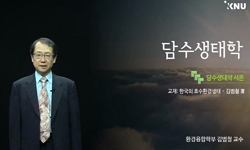During a survey of indigenous prokaryotic species diversity of the upstream Nakdong River, South Korea, 12 bacterial strains were isolated for further analysis. These bacterial strains were identified showing at least 98.7% 16S rRNA gene sequence simi...
http://chineseinput.net/에서 pinyin(병음)방식으로 중국어를 변환할 수 있습니다.
변환된 중국어를 복사하여 사용하시면 됩니다.
- 中文 을 입력하시려면 zhongwen을 입력하시고 space를누르시면됩니다.
- 北京 을 입력하시려면 beijing을 입력하시고 space를 누르시면 됩니다.
https://www.riss.kr/link?id=A107494630
-
저자
Hyangmi Kim (낙동강국립생물자원관) ; 한지혜 (국립낙동강생물자원관)
- 발행기관
- 학술지명
- 권호사항
-
발행연도
2021
-
작성언어
English
- 주제어
-
등재정보
KCI등재
-
자료형태
학술저널
-
수록면
134-141(8쪽)
-
KCI 피인용횟수
0
- DOI식별코드
- 제공처
-
0
상세조회 -
0
다운로드
부가정보
다국어 초록 (Multilingual Abstract)
During a survey of indigenous prokaryotic species diversity of the upstream Nakdong River, South Korea, 12 bacterial strains were isolated for further analysis. These bacterial strains were identified showing at least 98.7% 16S rRNA gene sequence similarity with known bacterial species that were previously unreported in South Korea. The 12 bacterial strains were phylogenetically diverse and assigned to four classes, eight orders, nine families, and ten different genera. The isolates were identified as Leucobacter holotrichiae (99.1%), Leucobacter tardus (99.9%), Rhodococcus rhodochrous (99.9%), Tessaracoccus oleiagri (100%), and Paeniglutamicibacter cryotolerans (99.3%), of the class Actinobacteria; Bacillus coagulans (99.7%) and Bacillus wudalianchiensis (99.1%) of the class Bacilli; Ochrobactrum pseudogrignonense (99.2%) and Paracoccus thiocyanatus (100%) of the class Alphaproteobacteria; and Ideonella azotifigens (99.0%), Polaromonas glacialis (99.3%), and Herbaspirillum seropedicae (99.5%) of the class Betaproteobacteria. The cellular and colonial morphology, biochemical properties, and phylogenetic position of these isolates were examined, and species descriptions are provided.
참고문헌 (Reference)
1 Kim, T., "Tracing river water versus wastewater sources of trace elements using rare earth ele-ments in the Nakdong River estuarine waters" 160 : 111589-, 2020
2 Fitch, W. M., "Toward defining the course of evolution: minimum change for a specific tree topology" 20 : 406-416, 1971
3 Saitou, N., "The neighbor-joining method: a new method for reconstructing phylogenetic trees" 4 : 406-425, 1987
4 Lee, J. H., "Spatial distribution of polycyclic aromatic hydrocarbon and polychlorinated biphenyl sources in the Nakdong River Estuary, South Korea" 52 (52): 1173-1183, 2017
5 Tekile, A., "Mini-review on river eutrophication and bottom improvement techniques, with special emphasis on the Nakdong River" 30 : 113-121, 2015
6 Kim, K, "Microbial Diversity Analysis of Sediment from Nakdong River Estuary in the Republic of Korea Using 16S rRNA Gene Amplicon Sequencing" 7 (7): e01186-18, 2018
7 Kumar, S., "MEGA7: mole-cular evolutionary genetics analysis version 7.0 for bigger datasets" 33 : 1870-1874, 2016
8 Yoon, S. H., "Introducing EzBioCloud: a taxonomically united database of 16S rRNA gene sequences and whole-genome assemblies" 67 : 1613-1617, 2017
9 Oh, S. M., "Identification of estrogen-like effects and biologically active compounds in river water using bioassays and chemical analysis" 407 (407): 5787-5794, 2009
10 Felsenstein, J., "Evolutionary trees from DNA sequences: a maximum likelihood approach" 17 : 368-376, 1981
1 Kim, T., "Tracing river water versus wastewater sources of trace elements using rare earth ele-ments in the Nakdong River estuarine waters" 160 : 111589-, 2020
2 Fitch, W. M., "Toward defining the course of evolution: minimum change for a specific tree topology" 20 : 406-416, 1971
3 Saitou, N., "The neighbor-joining method: a new method for reconstructing phylogenetic trees" 4 : 406-425, 1987
4 Lee, J. H., "Spatial distribution of polycyclic aromatic hydrocarbon and polychlorinated biphenyl sources in the Nakdong River Estuary, South Korea" 52 (52): 1173-1183, 2017
5 Tekile, A., "Mini-review on river eutrophication and bottom improvement techniques, with special emphasis on the Nakdong River" 30 : 113-121, 2015
6 Kim, K, "Microbial Diversity Analysis of Sediment from Nakdong River Estuary in the Republic of Korea Using 16S rRNA Gene Amplicon Sequencing" 7 (7): e01186-18, 2018
7 Kumar, S., "MEGA7: mole-cular evolutionary genetics analysis version 7.0 for bigger datasets" 33 : 1870-1874, 2016
8 Yoon, S. H., "Introducing EzBioCloud: a taxonomically united database of 16S rRNA gene sequences and whole-genome assemblies" 67 : 1613-1617, 2017
9 Oh, S. M., "Identification of estrogen-like effects and biologically active compounds in river water using bioassays and chemical analysis" 407 (407): 5787-5794, 2009
10 Felsenstein, J., "Evolutionary trees from DNA sequences: a maximum likelihood approach" 17 : 368-376, 1981
11 Felsenstein, J, "Confidence limits on phylogenies : an app-roach using the bootstrap" 39 : 783-791, 1985
12 Glöckner, F. O., "Compara-tive 16S rRNA analysis of lake bacterioplankton reveals globally distributed phylogenetic clusters including an abundant group of actinobacteria" 66 : 5053-5065, 2000
13 Newton, R. J., "A guide to the natural history of freshwater lake bacteria" 75 : 14-49, 2011
14 Weisburg, W. G., "16S ribosomal DNA amplification for phylogenetic study" 173 : 697-703, 1991
동일학술지(권/호) 다른 논문
-
Eighteen unreported radiation-resistant bacterial species isolated from Korea in 2018
- 국립생물자원관
- 맹수현
- 2021
- KCI등재
-
- 국립생물자원관
- Heeyoung Kang
- 2021
- KCI등재
-
- 국립생물자원관
- 이준모
- 2021
- KCI등재
-
Chloroplast genome of the conserved Aster altaicus var. uchiyamae B2015-0044 as genetic barcode
- 국립생물자원관
- 이민지
- 2021
- KCI등재
분석정보
인용정보 인용지수 설명보기
학술지 이력
| 연월일 | 이력구분 | 이력상세 | 등재구분 |
|---|---|---|---|
| 2028 | 평가예정 | 재인증평가 신청대상 (재인증) | |
| 2022-01-01 | 평가 | 등재학술지 유지 (재인증) |  |
| 2019-01-01 | 평가 | 등재학술지 선정 (계속평가) |  |
| 2018-01-01 | 평가 | 등재후보학술지 유지 (계속평가) |  |
| 2017-01-01 | 평가 | 등재후보학술지 유지 (계속평가) |  |
| 2015-01-01 | 평가 | 등재후보학술지 선정 (신규평가) |  |
학술지 인용정보
| 기준연도 | WOS-KCI 통합IF(2년) | KCIF(2년) | KCIF(3년) |
|---|---|---|---|
| 2016 | 0 | 0 | 0 |
| KCIF(4년) | KCIF(5년) | 중심성지수(3년) | 즉시성지수 |
| 0 | 0 | 0 | 0 |




 ScienceON
ScienceON



